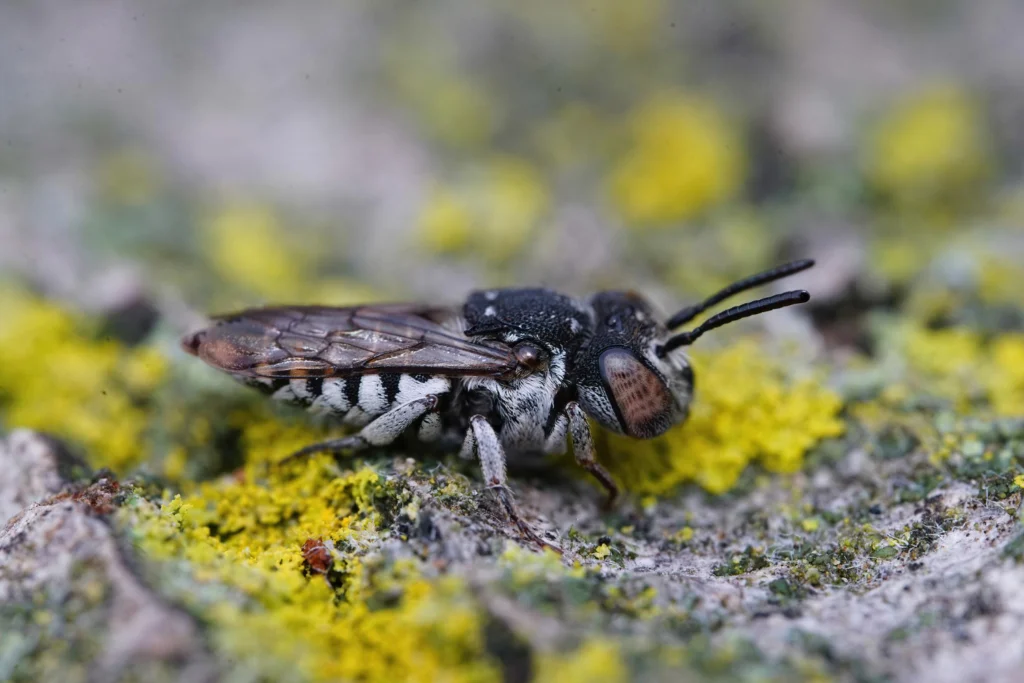Introduction
The Sweat Bees Halictidae is a group of small, vibrant bees known for their striking metallic green or blue sheen and their amazing attraction to human sweating. Found on every continent except Antarctica, the Sweat Bees Halictidae plays a vital role in pollinating wildflowers, fruits, and vegetables.
Unlike honeybees, the Sweat Bees Halictidae can be solitary or semi-social. Their adaptability allows them to thrive in gardens, meadows, and even urban parks, making them crucial allies for both ecosystems and agriculture.
Key Specifications of Sweat Bee Halictidae
| Specification | Details |
| Scientific Family | Halictidae |
| Common Name | Sweat Bee (Halictidae) |
| Size | 4–15 mm depending on species |
| Appearance | Metallic green, blue, or bronze; slender bodies |
| Habitat | Gardens, meadows, forest edges, urban green spaces |
| Diet | Nectar, pollen, occasional salts from sweat |
| Lifespan | 4–6 weeks as adults; 1 year lifecycle including larvae |
| Nesting | Underground burrows or rotting wood |
| Behaviour | Solitary or semi-social; exceptional pollinators |
| Conservation Status | Not endangered but vulnerable to pesticides and habitat loss |
Habitat & Behaviour
The Sweat Bees Halictidae is incredibly versatile, inhabiting environments from rural meadows to city gardens. Many species dig small tunnels in soil or rotting wood, creating brood cells lined with wax-like secretions.
These bees are named for their attraction to the salts found in human perspiration. While their visits can surprise gardeners, the Sweat Bees Halictidae is gentle and rarely stings unless trapped or threatened.
Diet & Pollination Role
Feeding primarily on nectar and pollen, the Sweat Bees Halictidae is one of the most effective pollinators of wildflowers, berries, and vegetable crops. Their small size allows them to pollinate tiny blooms that larger bees might overlook, ensuring plant diversity and healthy ecosystems.
Carpenter Bee Xylocopa Classification and Habitat Complete Guide
Life Cycle
The Sweat Bees Halictidae has an annual cycle. Mated females overwinter in soil burrows and emerge in spring to establish new nests. Depending on the species, some maintain solitary nests, while others create small colonies with a simple social hierarchy.
Conservation & How to Help
Although widespread, the Sweat Bees (Halictidae) faces threats from pesticide use, soil compaction, and habitat loss. To support them:
- Plant diverse, pesticide-free flowers.
- Leave bare soil patches for nesting.
- Avoid heavy mulching to maintain access to ground.
Encouraging Sweat Bee (Halictidae) populations helps gardens and farms thrive.
FAQs about Sweat Bee (Halictidae)
Q1. Why are they called Sweat Bees?
Because the Sweat Bee (Halictidae) is attracted to the salts in human sweat, occasionally landing on skin to drink.
Q2. Do Sweat Bees sting?
Generally no. The Sweat Bee (Halictidae) is mild-mannered and only stings if squeezed or threatened.
Q3. Are they important for crops?
Yes. The Sweat Bee (Halictidae) is an efficient pollinator for berries, vegetables, and wildflowers.
Q4. How can I attract them to my garden?
Grow nectar-rich flowers and leave small bare soil patches for nesting to invite Sweat Bee Halictidae.
Q5. Are Sweat Bees endangered?
Most Sweat Bees Halictidae species are not endangered but are vulnerable to habitat destruction and chemicals.







